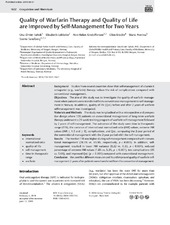| dc.contributor.author | Sølvik, Una Ørvim | en_US |
| dc.contributor.author | Løkkebø, Elisabeth Sellevoll | en_US |
| dc.contributor.author | Kristoffersen, Ann-Helen | en_US |
| dc.contributor.author | Brodin, Ellen Elisabeth | en_US |
| dc.contributor.author | Averina, Maria | en_US |
| dc.contributor.author | Sandberg, Sverre | en_US |
| dc.date.accessioned | 2020-08-06T08:15:01Z | |
| dc.date.available | 2020-08-06T08:15:01Z | |
| dc.date.issued | 2019 | |
| dc.Published | Sølvik UØ, Løkkebø ES, Kristoffersen A, Brodin EE, Averina M, Sandberg S. Quality of warfarin therapy and quality of life are improved by self-management for two years. Thrombosis and Haemostasis. 2019;19(10):1632-1641 | eng |
| dc.identifier.issn | 0340-6245 | |
| dc.identifier.uri | https://hdl.handle.net/1956/23493 | |
| dc.description.abstract | Background: Studies from several countries show that self-management of vitamin K antagonist (e.g., warfarin) therapy reduce the risk of complications compared with conventional management. Objectives: The aim of this study was to investigate the quality of warfarin management when patients were transferred from conventional management to self-management in Norway. In addition, quality of life (QoL) before and after 2 years of warfarin self-management was investigated. Materials and Methods: The study was longitudinal with a retrospective and prospective design where 126 patients on conventional management of long-term warfarin therapy underwent a 21-week training program of warfarin self-management followed by 2 years of self-management. The outcomes of the study were time in therapeutic range (TTR), the variance of international normalized ratio (INR) values, extreme INR values (INR ≤ 1.5 and ≥ 5), complications, and QoL, comparing the 2-year period of the conventional management with the 2-year period with the self-management. Results: The median TTR was higher during self-management compared with conventional management (78.1% vs. 65.9%, respectively, p < 0.001). In addition, self-management resulted in lower INR variance (0.22 vs. 0.33, p < 0.001), reduced percentage of extreme INR values (1.8% vs. 5.3%, p < 0.001), less complications (0% vs. 5.6%), and improved QoL (p < 0.001) compared with conventional management. Conclusion: We used five different measures and found improved quality of warfarin self-management 2 years after patients were transferred from the conventional management. | en_US |
| dc.language.iso | eng | eng |
| dc.publisher | Thieme | eng |
| dc.rights | Attribution-NonCommercial-NoDerivs CC BY-NC-ND | eng |
| dc.rights.uri | http://creativecommons.org/licenses/by-nc-nd/4.0/ | eng |
| dc.title | Quality of warfarin therapy and quality of life are improved by self-management for two years | en_US |
| dc.type | Peer reviewed | |
| dc.type | Journal article | |
| dc.date.updated | 2020-01-10T11:59:42Z | |
| dc.description.version | publishedVersion | en_US |
| dc.rights.holder | Copyright 2019 Georg Thieme Verlag KG | |
| dc.identifier.doi | https://doi.org/10.1055/s-0039-1693703 | |
| dc.identifier.cristin | 1714960 | |
| dc.source.journal | Thrombosis and Haemostasis | |

